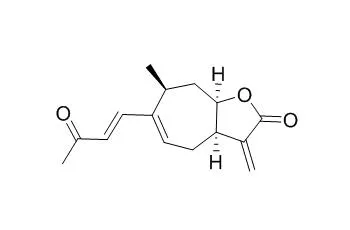| In vitro: |
| Planta Med. 2009 Oct;75(12):1363-8. | | The antiprotozoal activity of sixteen asteraceae species native to Sudan and bioactivity-guided isolation of xanthanolides from Xanthium brasilicum.[Pubmed: 19431098 ] | Bioactivity-guided fractionation resulted in the isolation of four bioactive sesquiterpene lactones (STL) of the xanthanolide series (4,5-seco-guaianolide-type).
METHODS AND RESULTS:
They were identified by spectroscopic means as 8-Epixanthatin (1), 8-Epixanthatin 1beta,5beta-epoxide (2), and as the dimers pungiolide A (4) as well as pungiolide B (5). Two further modified xanthanolide sesquiterpene lactones, xanthipungolide (3) and 4,15-dinor-1,11(13)-xanthadiene-3,5beta:12,8beta-diolide (6) were isolated. While xanthipungolide turned out to be inactive against the tested parasites, the dinor-xanthanlide showed significant activity against T. brucei rhodesiense and L. donovani. All isolated compounds were previously known from other Xanthium species but this is the first report on their occurrence in X. brasilicum, and, most notably, on their antiprotozoal activity.
CONCLUSIONS:
As the most active single compound from this extract, 8-Epixanthatin 1beta,5beta-epoxide showed IC(50) values of 0.09, 2.95, 0.16 and 1.71 microg/mL (0.33, 11.3, 0.6 and 6.5 microM) against T. brucei rhodesiense, T. cruzi, L. donovani and P. falciparum, respectively, while its cytotoxicity against rat myoblast cells used as control was determined at 5.8 microg/mL (22.1 microM). Besides assessment of their antiprotozoal activity, the structural assignments for the dimeric xanthanolides pungiolide A and B were reinvestigated and fully established. | | Physiologia Plantarum, 1999, 106(3):326–330. | | 8-Epixanthatin, a light-induced growth inhibitor, mediates the phototropic curvature in sunflower (Helianthus annuus) hypocotyls[Reference: WebLink] |
METHODS AND RESULTS:
The distribution of the endogenous auxin-inhibiting substance, 8-Epixanthatin, was determined in the lighted and shaded sides of phototropically-stimulated, de-etiolated sunflower (Helianthus annuus L. cv. Taiyo) hypocotyls. From 40 min after the onset of phototropic stimulation, the growth rate at the lighted side was inhibited, whereas that at the shaded side showed no change. In the lighted side, 8-Epixanthatin increased by 20 min after the onset of unilateral illumination and, after 40 min, reached a 3-fold larger concentration than that in the shaded side. Unilateral application of 8-Epixanthatin suppressed the growth of etiolated hypocotyls at the applied side only, causing the hypocotyls to bend at the site of application.
CONCLUSIONS:
It is concluded that phototropic curvature in sunflower hypocotyls is caused by a lateral gradient of the auxin-inhibiting substance 8-Epixanthatin. |
|






 Cell. 2018 Jan 11;172(1-2):249-261.e12. doi: 10.1016/j.cell.2017.12.019.IF=36.216(2019)
Cell. 2018 Jan 11;172(1-2):249-261.e12. doi: 10.1016/j.cell.2017.12.019.IF=36.216(2019) Cell Metab. 2020 Mar 3;31(3):534-548.e5. doi: 10.1016/j.cmet.2020.01.002.IF=22.415(2019)
Cell Metab. 2020 Mar 3;31(3):534-548.e5. doi: 10.1016/j.cmet.2020.01.002.IF=22.415(2019) Mol Cell. 2017 Nov 16;68(4):673-685.e6. doi: 10.1016/j.molcel.2017.10.022.IF=14.548(2019)
Mol Cell. 2017 Nov 16;68(4):673-685.e6. doi: 10.1016/j.molcel.2017.10.022.IF=14.548(2019)